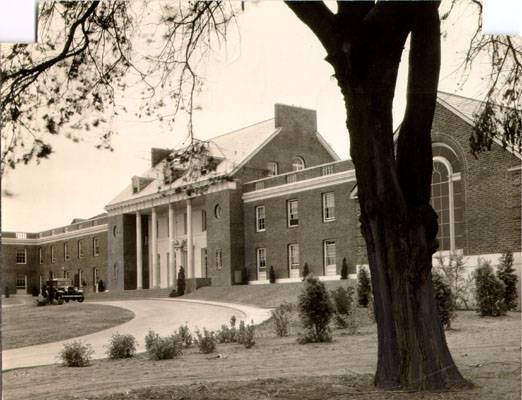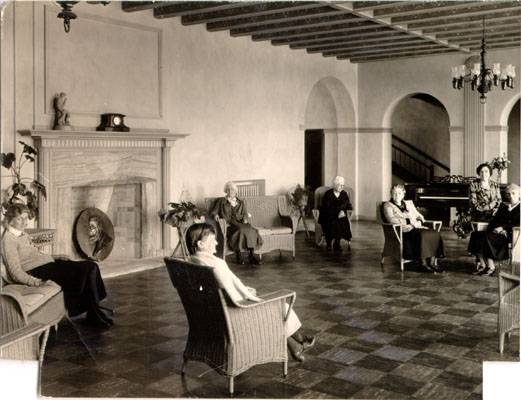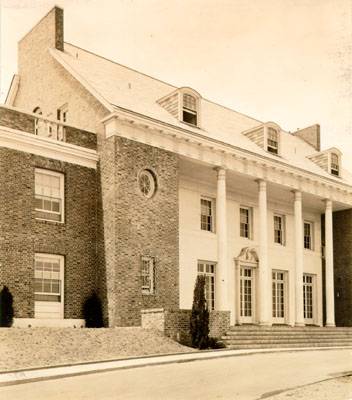University Mound Ladies Home: Difference between revisions
No edit summary |
(readded intern Ava Obrecht's name for her contribution and time looking into the current issues around the UMLH in July 2014) |
||
| Line 1: | Line 1: | ||
'''<font face = Papyrus> <font color = maroon> <font size = 4>Historical Essay</font></font> </font>''' | '''<font face = Papyrus> <font color = maroon> <font size = 4>Historical Essay</font></font> </font>''' | ||
''-Researched with help from Ava Obrecht and the UMLH Board.'' | |||
[[Image:University mound exterior with drive 16 june 1932 AAD-0005.jpg]] | [[Image:University mound exterior with drive 16 june 1932 AAD-0005.jpg]] | ||
| Line 33: | Line 34: | ||
LLC., which resulted in litigation. On May 8, 2014, the UMLH board announced the closure of the home, having exhausted all funds. A short-term loan of approximately $2 million was taken out to meet payroll and sustain operations until new placements could be found for residents. This necessitated the sale of the property. | LLC., which resulted in litigation. On May 8, 2014, the UMLH board announced the closure of the home, having exhausted all funds. A short-term loan of approximately $2 million was taken out to meet payroll and sustain operations until new placements could be found for residents. This necessitated the sale of the property. | ||
Several other residential care facilities expressed interest in purchasing the building, but there were no viable proposals submitted that would have allowed the residents to remain, and the board announced an intention to sell the building to a local private school. At this time, AgeSong expressed an interest in taking over operations of the building, promised to keep remaining residents in place, and enlisted resident families, politicians, and the local press in their campaign | Several other residential care facilities expressed interest in purchasing the building, but there were no viable proposals submitted that would have allowed the residents to remain, and the board announced an intention to sell the building to a local private school. At this time, AgeSong expressed an interest in taking over operations of the building, promised to keep remaining residents in place, and enlisted resident families, politicians, and the local press in their campaign. Supervisor David Campos introduced legislation that would have imposed a moratorium on any change in use, potentially blocking the use of the building by the school. Due to concerns about several factors that might prevent the close of a sale of the property, the UMLH board offered AgeSong an opportunity to match the school's offer. | ||
AgeSong submitted a successful offer for the property, and on August 15, 2014, University Mound Ladies Home ceased to exist, and AgeSong assumed control of the 350 University St. property. At that time, about half the residents who were living in the building when the closure was announced still lived there. The other half had already found new homes. Part of the proceeds from the sale are being used to provide subsidies to the residents who had moved out. Agesong is currently operating their own residential care facility at the University Mound location. | AgeSong submitted a successful offer for the property, and on August 15, 2014, University Mound Ladies Home ceased to exist, and AgeSong assumed control of the 350 University St. property. At that time, about half the residents who were living in the building when the closure was announced still lived there. The other half had already found new homes. Part of the proceeds from the sale are being used to provide subsidies to the residents who had moved out. Agesong is currently operating their own residential care facility at the University Mound location. | ||
Latest revision as of 14:17, 23 September 2014
Historical Essay
-Researched with help from Ava Obrecht and the UMLH Board.
University Mound Ladies Home as it looked in 1932.
Photo: San Francisco Public Library, San Francisco History Center
For 130 years, the University Mound Ladies Home was operated as one of San Francisco’s few affordable assisted-living homes. The original benefactor of the home was James Lick, who left a substantial portion of his 3 million dollar fortune to be used for charitable causes. The home was a registered as a 501(c)3, making it an official nonprofit organization. Originally, only women were admitted to the home, but after 2004 men were allowed to be residents in the home.
Although Lick had the resources for the creation of a low-income assisted living facility for women, the idea for the University Mound Ladies Home came from a woman named Mary Staples, whose husband assisted Lick in the writing of his will. Lick asked Mrs. Staples if she had any requests, and she appealed to him to establish a home for aging, unsupported women. Lick proposed that he would divide out $50,000 for the home, but upon Mrs. Staples’ insistence, he doubled the amount to $100,000, which would provide a sizable endowment that would be able to earn interest for many years to come.
Residents in the Ladies Home, June 16, 1932.
Photo: San Francisco Public Library, San Francisco History Center
The home was founded in a three-story building that sits on 25 acres in the Portola District. The building was originally made of wood, but it was redone by Martin J. Rist in 1932 with the red brick facade that is still seen today. Today the University Mound Ladies Home only owns 3 of the 25 acres. When the land was still a part of the home, the residents as well as the staff members farmed most of the land, taking care of animals as well as growing food. At the time, women were admitted to the University Mound Ladies Home only if they were of good health. They were allowed to go into the city if they wished.
When it opened in 1884, admission to the home required a one-time payment of $300. With this retainer, the home promised to care for these women for the rest of their lives. In 1939, admission was either $50 a month, or $3,000 for a lifetime of care.
Beginning in the 21st century, The University Mound Ladies Home suffered financial instability, with increasing amounts of the endowment required to subsidize the below-market affordable rates (around $2800 in 2000) In 2007, when the board reported that the endowment had run out, they approached former mayor Gavin Newsom for help. In 2008, The San Francisco Department of Public Health began placing residents at the home, but no other city funding was received
University Mound Ladies Home, 1932
Photo: San Francisco Public Library, San Francisco History Center
A new board was installed in 2008, and they instituted new programs, including hospice and palliative care, and began admitting men, in order to make the home financially sustainable. Despite their best efforts, including obtaining foundation grants and other fundraising, the costs of operating the home exceeded the available funds. In 2013, the board signed an unsuccessful management agreement with AgeSong Living LLC., which resulted in litigation. On May 8, 2014, the UMLH board announced the closure of the home, having exhausted all funds. A short-term loan of approximately $2 million was taken out to meet payroll and sustain operations until new placements could be found for residents. This necessitated the sale of the property.
Several other residential care facilities expressed interest in purchasing the building, but there were no viable proposals submitted that would have allowed the residents to remain, and the board announced an intention to sell the building to a local private school. At this time, AgeSong expressed an interest in taking over operations of the building, promised to keep remaining residents in place, and enlisted resident families, politicians, and the local press in their campaign. Supervisor David Campos introduced legislation that would have imposed a moratorium on any change in use, potentially blocking the use of the building by the school. Due to concerns about several factors that might prevent the close of a sale of the property, the UMLH board offered AgeSong an opportunity to match the school's offer.
AgeSong submitted a successful offer for the property, and on August 15, 2014, University Mound Ladies Home ceased to exist, and AgeSong assumed control of the 350 University St. property. At that time, about half the residents who were living in the building when the closure was announced still lived there. The other half had already found new homes. Part of the proceeds from the sale are being used to provide subsidies to the residents who had moved out. Agesong is currently operating their own residential care facility at the University Mound location.
Sources:
University Mound Ladies Home, “Our History.” Accessed on July 15 2014.
“S.F. Senior Care Home to be Sold to Private School.” J.K. Dineen. SF Gate. Accessed on July 15 2014.
San Francisco City Hall hearing, July 10, 2014.



